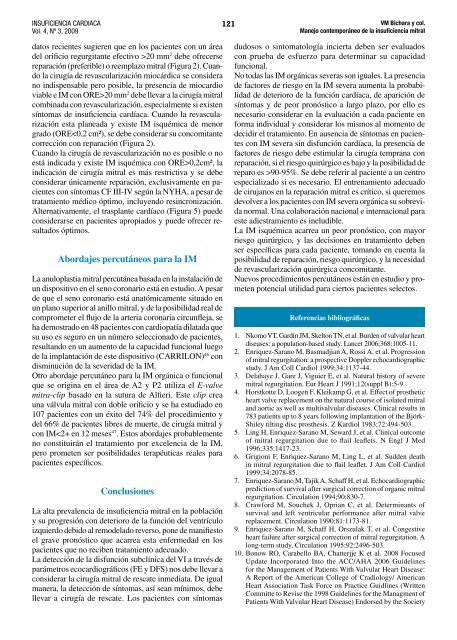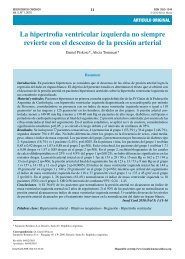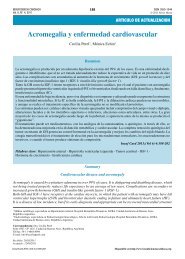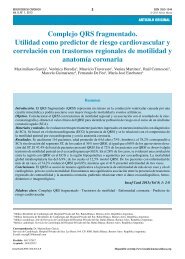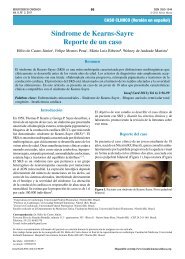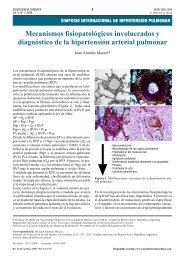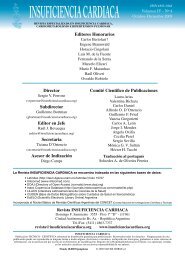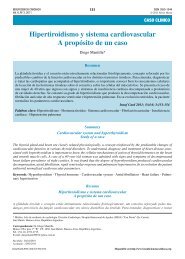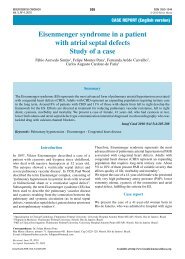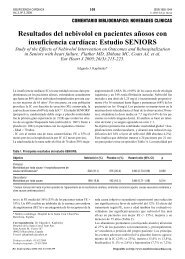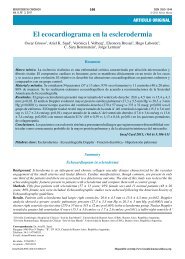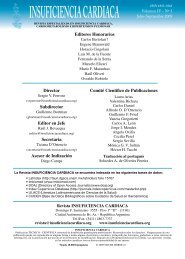Manejo contemporáneo de la insuficiencia mitral severa - SciELO
Manejo contemporáneo de la insuficiencia mitral severa - SciELO
Manejo contemporáneo de la insuficiencia mitral severa - SciELO
Create successful ePaper yourself
Turn your PDF publications into a flip-book with our unique Google optimized e-Paper software.
INSUFICIENCIA CARDIACA<br />
Vol. 4, Nº 3, 2009<br />
121 VM Bichara y col.<br />
<strong>Manejo</strong> contemporáneo <strong>de</strong> <strong>la</strong> <strong>insuficiencia</strong> <strong>mitral</strong><br />
datos recientes sugieren que en los pacientes con un área<br />
<strong>de</strong>l orificio regurgitante efectivo >20 mm 2 <strong>de</strong>be ofrecerse<br />
reparación (preferible) o reemp<strong>la</strong>zo <strong>mitral</strong> (Figura 2). Cuando<br />
<strong>la</strong> cirugía <strong>de</strong> revascu<strong>la</strong>rización miocárdica se consi<strong>de</strong>ra<br />
no indispensable pero posible, <strong>la</strong> presencia <strong>de</strong> miocardio<br />
viable e IM con ORE>20 mm 2 <strong>de</strong>be llevar a <strong>la</strong> cirugía <strong>mitral</strong><br />
combinada con revascu<strong>la</strong>rización, especialmente si existen<br />
síntomas <strong>de</strong> <strong>insuficiencia</strong> cardíaca. Cuando <strong>la</strong> revascu<strong>la</strong>rización<br />
esta p<strong>la</strong>neada y existe IM isquémica <strong>de</strong> menor<br />
grado (ORE0,2cm², <strong>la</strong><br />
indicación <strong>de</strong> cirugía <strong>mitral</strong> es más restrictiva y se <strong>de</strong>be<br />
consi<strong>de</strong>rar únicamente reparación, exclusivamente en pacientes<br />
con síntomas CF III-IV según <strong>la</strong> NYHA, a pesar <strong>de</strong><br />
tratamiento médico óptimo, incluyendo resincronización.<br />
Alternativamente, el trasp<strong>la</strong>nte cardíaco (Figura 5) pue<strong>de</strong><br />
consi<strong>de</strong>rarse en pacientes apropiados y pue<strong>de</strong> ofrecer resultados<br />
óptimos.<br />
Abordajes percutáneos para <strong>la</strong> IM<br />
La anulop<strong>la</strong>stia <strong>mitral</strong> percutánea basada en <strong>la</strong> insta<strong>la</strong>ción <strong>de</strong><br />
un dispositivo en el seno coronario está en estudio. A pesar<br />
<strong>de</strong> que el seno coronario está anatómicamente situado en<br />
un p<strong>la</strong>no superior al anillo <strong>mitral</strong>, y <strong>de</strong> <strong>la</strong> posibilidad real <strong>de</strong><br />
comprometer el flujo <strong>de</strong> <strong>la</strong> arteria coronaria circunfleja, se<br />
ha <strong>de</strong>mostrado en 48 pacientes con cardiopatía di<strong>la</strong>tada que<br />
su uso es seguro en un número seleccionado <strong>de</strong> pacientes,<br />
resultando en un aumento <strong>de</strong> <strong>la</strong> capacidad funcional luego<br />
<strong>de</strong> <strong>la</strong> imp<strong>la</strong>ntación <strong>de</strong> este dispositivo (CARRILON) 46 con<br />
disminución <strong>de</strong> <strong>la</strong> severidad <strong>de</strong> <strong>la</strong> IM.<br />
Otro abordaje percutáneo para <strong>la</strong> IM orgánica o funcional<br />
que se origina en el área <strong>de</strong> A2 y P2 utiliza el E-valve<br />
mitra-clip basado en <strong>la</strong> sutura <strong>de</strong> Alfieri. Este clip crea<br />
una válvu<strong>la</strong> <strong>mitral</strong> con doble orificio y se ha estudiado en<br />
107 pacientes con un éxito <strong>de</strong>l 74% <strong>de</strong>l procedimiento y<br />
<strong>de</strong>l 66% <strong>de</strong> pacientes libres <strong>de</strong> muerte, <strong>de</strong> cirugía <strong>mitral</strong> y<br />
con IM90-95%. Se <strong>de</strong>be referir al paciente a un centro<br />
especializado si es necesario. El entrenamiento a<strong>de</strong>cuado<br />
<strong>de</strong> cirujanos en <strong>la</strong> reparación <strong>mitral</strong> es crítico, si queremos<br />
<strong>de</strong>volver a los pacientes con IM <strong>severa</strong> orgánica su sobrevida<br />
normal. Una co<strong>la</strong>boración nacional e internacional para<br />
este adiestramiento es ineludible.<br />
La IM isquémica acarrea un peor pronóstico, con mayor<br />
riesgo quirúrgico, y <strong>la</strong>s <strong>de</strong>cisiones en tratamiento <strong>de</strong>ben<br />
ser específicas para cada paciente, tomando en cuenta <strong>la</strong><br />
posibilidad <strong>de</strong> reparación, riesgo quirúrgico, y <strong>la</strong> necesidad<br />
<strong>de</strong> revascu<strong>la</strong>rización quirúrgica concomitante.<br />
Nuevos procedimientos percutáneos están en estudio y prometen<br />
potencial utilidad para ciertos pacientes selectos.<br />
Referencias bibliográficas<br />
1. Nkomo VT, Gardin JM, Skelton TN, et al. Bur<strong>de</strong>n of valvu<strong>la</strong>r heart<br />
diseases: a popu<strong>la</strong>tion-based study. Lancet 2006;368:1005-11.<br />
2. Enriquez-Sarano M, Basmadjian A, Rossi A, et al. Progression<br />
of <strong>mitral</strong> regurgitation: a prospective Doppler echocardiographic<br />
study. J Am Coll Cardiol 1999;34:1137-44.<br />
3. De<strong>la</strong>haye J, Gare J, Viguier E, et al. Natural history of severe<br />
<strong>mitral</strong> regurgitation. Eur Heart J 1991;12(suppl B):5-9.<br />
4. Horstkotte D, Loogen F, Kleikamp G, et al. Effect of prosthetic<br />
heart valve rep<strong>la</strong>cement on the natural course of iso<strong>la</strong>ted <strong>mitral</strong><br />
and aortic as well as multivalvu<strong>la</strong>r diseases. Clinical results in<br />
783 patients up to 8 years following imp<strong>la</strong>ntation of the Björk-<br />
Shiley tilting disc prosthesis. Z Kardiol 1983;72:494-503.<br />
5. Ling H, Enriquez-Sarano M, Seward J, et al. Clinical outcome<br />
of <strong>mitral</strong> regurgitation due to f<strong>la</strong>il leaflets. N Engl J Med<br />
1996;335:1417-23.<br />
6. Grigioni F, Enriquez-Sarano M, Ling L, et al. Sud<strong>de</strong>n <strong>de</strong>ath<br />
in <strong>mitral</strong> regurgitation due to f<strong>la</strong>il leaflet. J Am Coll Cardiol<br />
1999;34:2078-85.<br />
7. Enriquez-Sarano M, Tajik A, Schaff H, et al. Echocardiographic<br />
prediction of survival after surgical correction of organic <strong>mitral</strong><br />
regurgitation. Circu<strong>la</strong>tion 1994;90:830-7.<br />
8. Crawford M, Souchek J, Oprian C, et al. Determinants of<br />
survival and left ventricu<strong>la</strong>r performance after <strong>mitral</strong> valve<br />
rep<strong>la</strong>cement. Circu<strong>la</strong>tion 1990;81:1173-81.<br />
9. Enriquez-Sarano M, Schaff H, Orszu<strong>la</strong>k T, et al. Congestive<br />
heart failure after surgical correction of <strong>mitral</strong> regurgitation. A<br />
long-term study. Circu<strong>la</strong>tion 1995;92:2496-503.<br />
10. Bonow RO, Carabello BA, Chatterjje K et al. 2008 Focused<br />
Update Incorporated Into the ACC/AHA 2006 Gui<strong>de</strong>lines<br />
for the Management of Patients With Valvu<strong>la</strong>r Heart Disease:<br />
A Report of the American College of Cradiology/ American<br />
Heart Association Task Force on Practice Guidlines (Written<br />
Committe to Revise the 1998 Gui<strong>de</strong>lines for the Managment of<br />
Patients With Valvu<strong>la</strong>r Heart Disease) Endorsed by the Society


